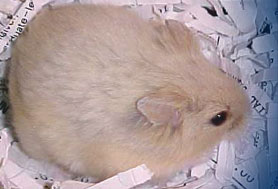

Dwarf Hamster Care
Basic Care:
| Housing | Bedding | Nesting Material | Cleaning | Exercise | Teeth | Food | Costs | Handling |
Advanced Care: Pairing
|Things to consider | Gender | Pairing | Housing | Baby Care | Campbells Dwarf Hamster Genetics
|
Tip: Introduce a male and female you hope to pair in neutral territory with hiding places. Males and females will usually get along within a few days if introduced like this. Choose a large container so both male and female have room to run if one is more aggressive than the other. |
How do I choose hamsters to breed?Pick hamsters that are 4 to 6 months old. Waiting until the hamsters are at least 4 months old is important because there are neurological problems that may be genetic that causes star gazing (the hamster looks straight up and falls over) or flipping (the hamster stares upwards and then does a partial or full back flip. People think this is funny and it has been on America's Funniest Home Videos. It isn't funny or cute or a "pet" trick. This is something that can and will pass on to the offspring. Usually if a hamster is going to show this trait, it will appear by 4 months of age. Pacing is another similar problem where the hamster will run the same track around the enclosure over and over again until the bedding is worn down in a path. Please pick well adjusted healthy hamsters to breed. Other genetic problems that Campbells dwarf hamsters are prone to have are diabetes and glaucoma (if you see one or both eyes bulging more than usual, your hamster probably has glaucoma. Waiting until the hamster is 4 months old also allows the female to mentally mature and to finish her own growing. Younger female are more prone to eating their young and having their own growth stunted if bred too early. As a final note, do not breed two mottled (spotted or patched ) animals together. Offspring from such a pairing will result in 1/4 eyeless toothless whites that will die within two weeks of birth. The mottled gene is dominant and only one parent needs to have it to pass on the patched/spotted pattern to offspring. Pairing HamstersChoose two healthy hamsters of the correct age and place them together in a roomy freshly cleaned cage. They must meet on neutral territory and cleaning the cage wipes away scent markings that the hamster may have left declaring it his or her cage. If the hamsters fight so that blood is drawn, immediately separate them. It is normal for the female to run from the male. The male may even sit on her but as long as they are not hurting each other, a little squeaking and getting to know each other is normal. Watch that the female does not attack the male. Some females get very aggressive once pregnant (it is uncommon but I have at least one pair where the male must be removed once is mate is pregnant or she will attack him constantly). If all goes well and the hamsters bond, mating should occur within a week or two. However females seem to be able to regulate their breeding cycles and it can take a bit longer for the female to become pregnant All pictures on this site are copyrighted by Odds and Endlers. Any unauthorized use is strictly prohibited. |
|
